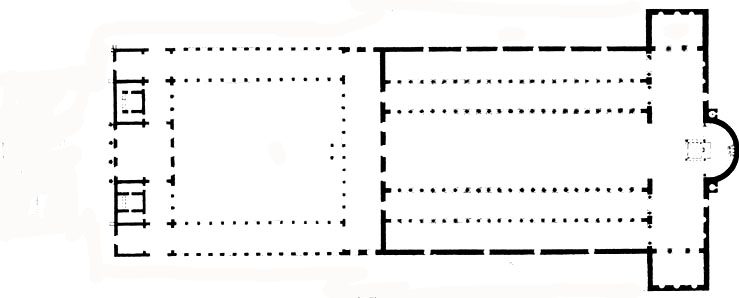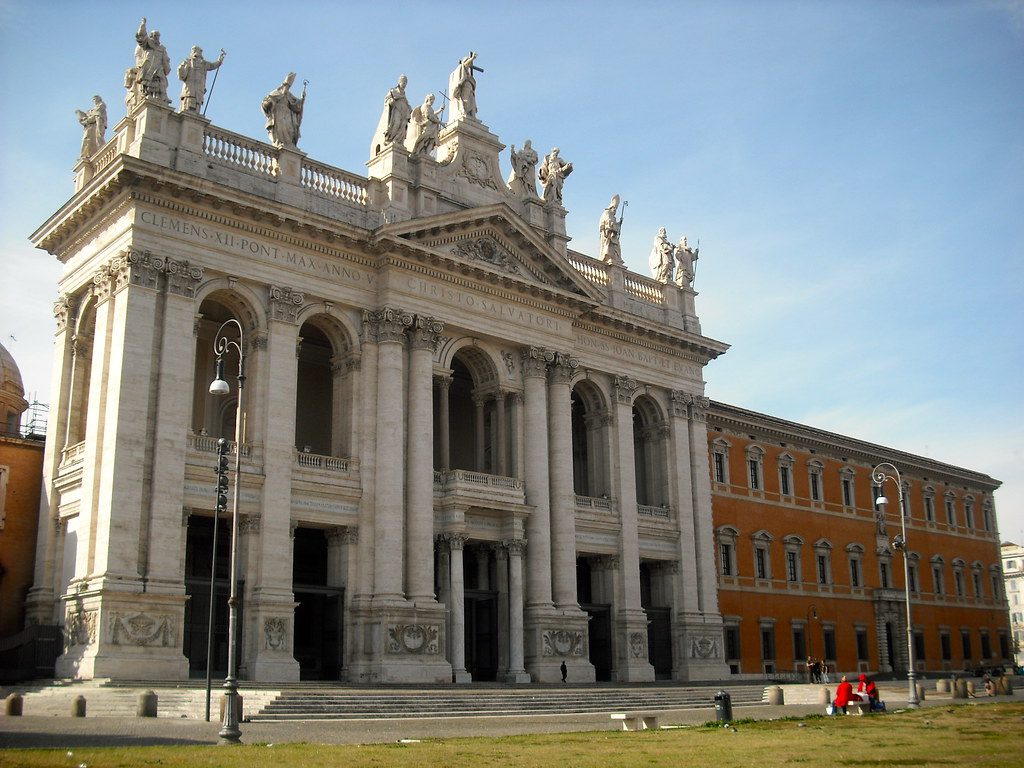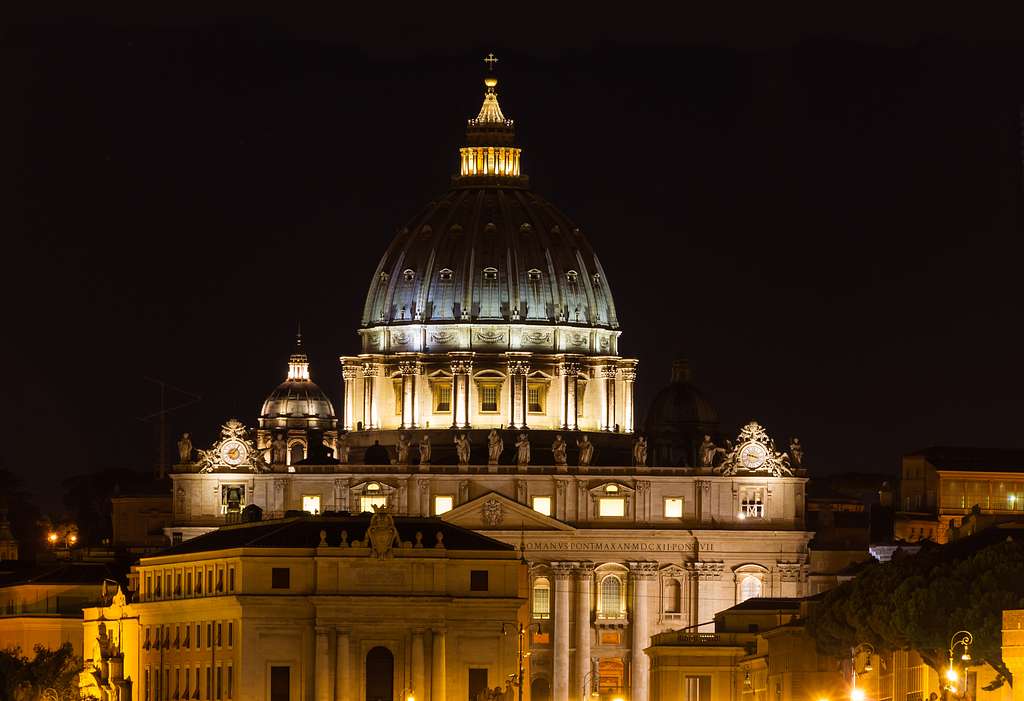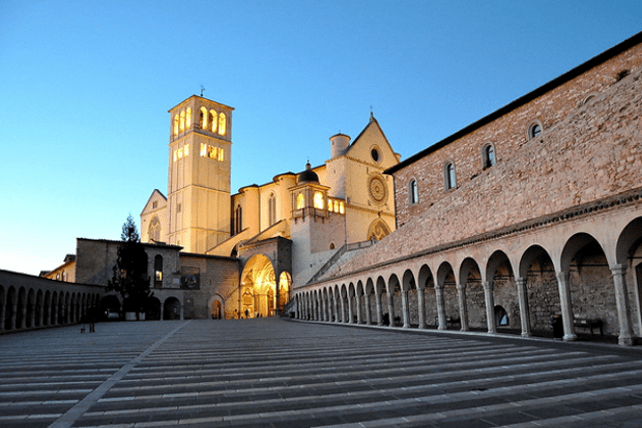A Brief Background on Basilicas
The term basilica (lit. “royal stoa”) comes from Ancient Greek and is the Latin equivalent of a stoa in the Greek East. A stoa is a covered walkway or portico usually for common (public) use. Basilica originally referred to a specific function and style of building in the ancient Roman Empire. Basilicas were normally rectangular with a central nave with long aisles on both sides. The roof was generally higher over the central nave and lower on the adjacent aisle. The structure was usually distinguished by ornate columns and had an apse (a semicircular recess covered by a vault or dome). Within the apse, the tribune (a raised platform) was placed and occupied by the Roman magistrates or the Emperor who sat in large ornate chairs. Basilicas were public buildings—commonly adjacent to the forum—and used by the Emperor or Judges for major events. The first known basilica was constructed in 184 BC and called the Basilica Porcia. Basilicas were also built as private residences and were known as palace basilicas.

After Constantine legalized Christianity, many basilicas were converted into churches. In the apse where the Emperor or Magistrates once stood, the altar and tabernacle were placed. With Our Lord Jesus Christ substantially present in the Eucharistic Sacrifice and reserved in the tabernacle, the basilica continued to be a “royal house” with the King of the Universe occupying his rightful place. Also placed within the apse was the chair of the bishop or priest who acts in persona Christi capitis (“in the person of Christ the Head”). Many churches throughout Europe and the Mediterranean were built with a basilica-style layout and in latter centuries, the style spread throughout the world. In the Catholic Church, the term basilica has now come to refer to certain churches of signficance without regard to the architectural form.
Two Types of Basilicas
There are two types of basilicas – Major Basilicas and Minor Basilicas. All four of the major basilicas are found within the city of Rome and are known as “papal basilicas”.

Major Papal Basilicas
The first of the major basilicas is the Archbasilica of Saint John Lateran. Its full name is the Archbasilica Cathedral of the Most Holy Savior and of Saints John the Baptist and the Evangelist in the Lateran. This palace basilica of Constantine the Great was gifted to Pope Miltiades in 313 to be used for a synod of bishops. Pope Sylvester I converted it into his residence and then ultimately into the Cathedral of Rome. It was officially dedicated in 324. The Lateran Basilica continues to be the cathedral of Rome and thus the Pope’s cathedral. On the basilica a inscription reads “Most Holy Lateran Church, mother and head of all the churches in the city and the world” which shows that Saint John Lateran is the mother church of every other Catholic Church in the world.
The other major basilicas are:
- Saint Peter’s Basilica — also known as the Vatican Basilica (seen to the right). The basilica is built over the burial place of Saint Peter the Apostle. The current basilica was consecrated on November 18, 1626.
- Saint Paul Outside-the-Walls — built over the grave of Saint Paul the Apostle. Like the basilica of Saint John Lateran, Pope Sylvester consecrated the original Saint Paul Outside-the-Walls in 324.
- Saint Mary Major — enshrines an image of our Blessed Mother as the health and protectress of the Roman People. The image is called Salus Populi Romani. The Basilica is the largest Catholic Marian church in Rome.

All of the major papal basilicas have a holy door which are only opened by the Pope himself during Jubilee years. Those who pass through a holy door are able to gain a plenary indulgence when fulfilling the usual conditions.

Minor Papal Basilicas
In addition to the four major papal basilicas, there are three minor papal basilicas:
- Saint Lawrence Outside-the-Walls (located in Rome) — built over the burial site of Saint Lawrence, one of the first seven deacons of Rome and martyred in 258.
- Basilica of Saint Francis of Assisi (located in Assisi – seen to the right) — mother church of the Order of Friars Minor Conventual. Construction was begun by Pope Gregory IX in 1228 the day after he canonized Francis. The basilica was consecrated in 1253 by Pope Innocent IV and in 1288, Pope Nicholas IV—the first Franciscan to be elected pope—declared the basilica a “papal church.”
- Basilica of Saint Mary of the Angels (located in Assisi) — built surrounding the Portiuncola, the little church where Saint Francis of Assisi realized his vocation, started the Franciscan order, and ultimately died in his cell. Pope Pius X raised the church to a papal basilica in 1909.
Other Minor Basilicas
In addition to the papal minor basilicas, there are Pontifical Minor Basilicas, Patriarchal Minor Basilicas, and finally Eccesiastical Minor Basilicas, the last being the category having the most. Usually referred to just as minor basilicas, all the aforementioned churches throughout Christendom have been given a special designation by the Holy Father. The title of minor basilica may be bestowed by the Holy Father because of the church’s architectural beauty, historical significance, and liturgical renown—especially in regards to the Holy Mass, penance, and other sacraments. Other possible reasons include that the body or significant relics of a saint is reserved in it or a sacred image is venerated there in a special way.
A minor basilica shares a special relationship with the Holy Father. Various privileges granted to and obligations required of the minor basilica highlight this important attachment to the Holy See and the Supreme Pontiff. Once a church has been granted basilica status, it can never lose that status, nor can it ever be closed without the permission of the Holy Father.
